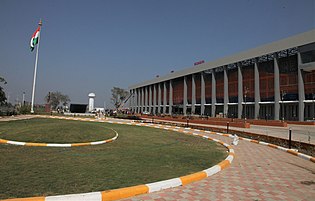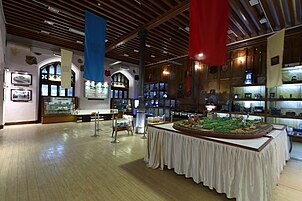Western Railway zone
 | |
 Western Railway System Map-9 | |
| Overview | |
|---|---|
| Headquarters | Churchgate, Mumbai, Maharashtra, India |
| Reporting mark | WR |
| Locale | Maharashtra, Gujarat, Rajasthan, Madhya Pradesh |
| Dates of operation | 5 November 1951–present |
| Predecessor | |
| Technical | |
| Track gauge | broad gauge, metre gauge & narrow gauge |
| Other | |
| Website | WR official website |
The Western Railway (abbreviated WR) is one of the 18 zones of Indian Railways, and is among the busiest railway networks in India. The major railway routes of Indian Railways which come under Western Railways are: Mumbai Central–Ratlam, Mumbai Central–Ahmedabad and Palanpur–Ahmedabad. The railway system is divided into six operating divisions: Ahmedabad, Vadodara, Rajkot, Bhavnagar, Ratlam, and Mumbai WR. Vadodara railway station, being the junction point for the Ahmedabad–Mumbai route and the Mumbai–Ratlam route towards New Delhi, is the busiest junction station in Western Railways and one of the busiest junctions of Indian Railways too, while Ahmedabad Division earns highest revenue followed by Mumbai Division and Vadodara Division. Surat railway station is one of the busiest railway station in Western Railway in non-junction category where more than 180 trains pass per day.[1][2]
Western Railway General Manager's official bungalow 'Bombarci' (abbreviation of Bombay, Baroda and Central India) is located on Altamont road in Cumbala hill, Mumbai.[3]
History[edit]
The Western Railway was created on 5 November 1951 by the merger of several state-owned railways, including the Bombay, Baroda and Central India Railway (BB&CI), and the Saurashtra Railway, Rajputana Railway and Jaipur State Railway. The narrow-gauge lines of Cutch State Railway was also merged into it in 1951.
The BB&CI Railway was itself inaugurated in 1855, starting with the construction of a 29-mile (47-km) broad-gauge track from Ankleshwar to Utran in Gujarat state on the west coast. In 1864, the railway was extended to Mumbai.
Subsequently, the project was further extended beyond Vadodara in a north easterly direction towards Godhra, Ratlam, Nagda and thereafter northwards towards Kota and Mathura, to eventually link with the Great Indian Peninsular Railway, now the Central Railway, which had already started operating in Mumbai in 1853. In 1860 Surat railway station was built and it was first railway station in Asia which is having platform on first floor (above ground level). In 1883, a metre-gauge railway system, initially linking Delhi with Agra, Jaipur and Ajmer, was established.
The first suburban service in Mumbai with steam traction was introduced in April 1867. It was extended to Churchgate in 1870. By 1900 45 trains in each direction were carrying over one million passengers annually.
The railways of several princely states were also integrated into the Western Railway. The Gaekwars of Baroda built the Gaekwar's Baroda State Railway (GBSR), which was merged into the BB&CI in 1949. Several railways of western Gujarat, including the Bhavnagar, Kathiawar, Jamnagar & Dwarka, Gondal, and Morvi railways were merged into the Saurashtra Railway in 1948. The Jodhpur–Bikaner Railway was taken over by Rajasthan state in 1949, after the western portion was ceded to the government of Pakistan.[4]
In 2002, the Jaipur and Ajmer divisions of the Western Railway became part of the newly created North Western Railway, and in April 2003 the Kota division of the Western Railway became part of the newly created West Central Railway.
Present[edit]

Western Railway headquarters is in Mumbai's Churchgate station and serves the entire state of Gujarat, some portions of Western Madhya Pradesh, and coastal Maharashtra. The Western coast of India served by Western Railway has a number of ports, most important among them being Kandla, Hajira, Surat, Dahej, Mundra, Okha, Veraval, Porbandar, Bhavnagar in Gujarat state and Mumbai in Maharashtra.
Navapur railway station is unique as it falls in both the states of Gujarat and Maharashtra because both were as a one state of Bombay State before 1960 and after States Reorganization Act the Navapur station was divided equally among Gujarat and Maharashtra.[5] So is the Surat railway station unique. It is Asia's one of the first railway station where the platforms is on the first floor, that is above the ground level. The ticket counter is on the ground floor.[6]
The Western Railway operates Electric multiple units (EMUs) on the Western line of the Mumbai Suburban Railway, which forms part of the Ahmedabad–Mumbai main line. The EMUs ply between Churchgate and Virar (60 km) and is projected to extend the service till Dahanu Road (Services actually started on 16 April 2013), while mainline electrical multiple units (MEMUs) service the section beyond Virar till Dahanu Road (60 km). EMUs are of 12-car or 15-car rakes and are differentiated as slow and fast locals. Slow trains halt at all stations, while fast ones halt at important stations only and are preferable over longer distances. The first electric train on this section was introduced in 1928 between Churchgate and Andheri.
Divisions[edit]
- Mumbai WR railway division
- Ahmedabad railway division
- Vadodara railway division
- Ratlam railway division
- Rajkot railway division
- Bhavnagar railway division
Western Railway Connects Statue of Unity[edit]
On 17th January, 2021, the Statue of Unity came on the railways map. Western Railway connected the Statue of Unity with Broad Gauge electrified line with Mumbai- Delhi main line at Vadodara. The project included gauge conversion of Dabhoi-Chandod section, new line from Chandod to Kevadiya(Statue of Unity) and electrification of Pratapnagar(Vadodara) to Kevadiya. The project was completed in a record time in close coordination with state government by Western Railway. It was inaugurated by Shri Narendra Modi, Prime Minister through video conferencing from New Delhi. 8 inaugural trains were flagged off from various parts of the country on same day. Vistadome coach has been introduced in Ahmedabad-Kevadiya Janshatabdi express.
Heritage Gallery, Mumbai[edit]
Conserving heritage, Western Railway has opened Heritage Gallery at its headquarters building at Churchgate, Mumbai. The Gallery has recently been renovated. It is a collection of various models of BB&CI era, the precursor of Western Railway. Many notes of agents of BB&CI dating back to 1860s have also been displayed. Suburban timetable of 1948, steam engine model, signalling equipment, Model of 1928 EMUs, working model of Auxiliary Warning System, etc. have been beautifully displayed.
The gallery gives an insight about the development of lines on Western Region of India. The BB&CI map dating back to 1930s shows us that the Western line started from Mumbai via Vadodara, Ratlam connected GIP Railway at Mathura to reach Delhi and further Peshawar. The Frontier Mail (Golden Temple Mail) used to run up to Peshawar. The Gallery is open for public free of cost during working hours and on special occasions.[7]
Major routes[edit]
- New Delhi–Mumbai main line
- Ahmedabad–Mumbai main line
- Ahmedabad–Delhi main line
- Jaipur–Ahmedabad line
- Udhna–Jalgaon line
- Gandhidham–Ahmedabad main line
- Viramgam–Okha line
- Surendranagar–Bhavnagar line
- Jamnagar–Porbandar line
- Rajkot–Somnath line
- Gandhidham–Palanpur section
- Gandhidham–Bhuj section
- Gandhidham–Kandla Port section
- Gandhidham–Samakhiali section
- Porbandar–Jetalsar section
- Maliya Miyana–Wankaner section
- Rajkot–Wankaner section
- Viramgam–Mahesana section
- Viramgam–Maliya Miyana section
- Viramgam–Surendra Nagar section
- Wankaner–Surendra Nagar section
- Dharangadhra–Surendra Nagar section
- Samakhiali–Maliya Miyana section
Major stations[edit]
- Ahmedabad Junction
- Amalner
- Anand Junction
- Andheri
- Ankleshwar Junction
- Badnagar
- Bandra Terminus
- Bharuch Junction
- Bhavnagar Terminus
- Bhildi Junction
- Bhuj
- Bilimora Junction
- Boisar
- Borivali
- Botad Junction
- Chhayapuri
- Chittaurgarh Junction
- Churchgate
- Dabhoi Junction
- Dadar Western
- Dahanu Road
- Dahod
- Dewas Junction
- Dhola Junction
- Dhrangadhra Junction
- Dondaicha
- Dr. Ambedkar Nagar (Mhow)
- Fatehabad Chandrawatiganj Junction
- Gandhidham Junction
- Gandhinagar Capital
- Godhra Junction
- Goregaon
- Hapa
- Indore Junction
- Jamnagar
- Jaora
- Jetalsar Junction
- Junagadh Junction
- Kalol Junction
- Mahesana Junction
- Mahuva Junction
- Maliya Miyana Junction
- Mandsaur
- Maninagar
- Meghnagar
- Morbi
- Mumbai Central
- Nadiad Junction
- Nagda Junction
- Nandurbar
- Navapur
- Navsari
- Neemuch
- Okha
- Palanpur Junction
- Palghar
- Palitana
- Pardi
- Patan
- Porbandar
- Rajkot Junction
- Ratlam Junction
- Sabarmati Junction
- Saphale
- Siddhpur
- Sihor Junction
- Somnath
- Surat
- Surendranagar Junction
- Udhna Junction
- Ujjain Junction
- Unjha
- Vadodara Junction
- Valsad
- Vapi
- Vasai Road
- Veraval Junction
- Viramgam Junction
- Virar
- Vyara
- Wankaner Junction
Loco sheds[edit]
- Electric Loco Shed, Vadodara
- Electric Loco Shed, Valsad
- Diesel Loco Shed, Vatva
- Diesel Loco Shed, Sabarmati
- Diesel Loco Shed, Ratlam
- Diesel Loco Shed, Gandhidham
- Diesel Loco Shed, Mhow
- Diesel Loco Shed, Pratapnagar
See also[edit]
References[edit]
- ↑ "About Western Railway". Total Train Info.
- ↑ "Railway Zones and Divisions". Press Information Bureau, Government of India.
- ↑ "HERITAGE INVENTORY OF INDIAN RAILWAYS:BUILDINGS AND STATIONS" (PDF). Indian Railways.
- ↑ "History of Western Railway". Western Railway.
- ↑ "इस रेलवे स्टेशन पर टिकट कटता है महाराष्ट्र में तो ट्रेन रुकती है गुजरात में". Bhaskar.
- ↑ "Surat Railway: Western Railway zone". Irctc News.
- ↑ "Churchgate Heritage Gallery". Museums of India.
Further reading[edit]
- Gupta, A. K.; Bhaskar, Ravinder (2018). Steam Heritage of Western Railway. Mumbai: Western Railway.






